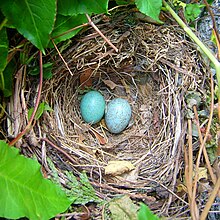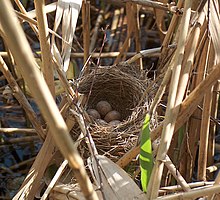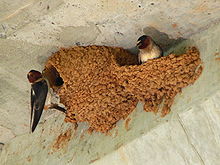Do Birds Sleep in Their Nests to Cover the Babies

This is a blackbird nest. In one case the eggs have hatched and are gone, the bird will no longer use the nest.
A bird nest is a place where a bird lays its eggs. There are all kinds of nests, including cup nests, holes in the ground, and piles of twigs and leaves. The word can be used every bit a noun or a verb, as in – a bird nests in a nest. They are in all kinds of sizes: some can be as big and heavy as a motorcar, like an old eagle'due south nest, while some tin be tiny equally a thimble, like the nest of a Bee Hummingbird.
Making a home [change | change source]
Usually, the female builds the nest, and the male helps her. In some species, though, the male does nothing, and in others, the male builds the nest and the female does nix.
Many birds "glue" their nests together with materials like spider webs, silk, mud, and even their own saliva (spit). Most nest builders like to put soft things within their nest. Some birds even put herbs and spices in their nest. Scientists think these herbs assist fight off bacteria in a way they can't completely empathise nonetheless.[i]
Types of nests [modify | change source]
Cup nest [change | change source]

Cup nest of the Peachy Reed-warbler

Cup nest of a Redwing, with infant chicks. Most all birds build cup nests like this.
The loving cup nest is probably the most common bird nest. Its name tells you that a cup nest is shaped like a cup or bowl. Many songbirds built cup nests. These nests can be congenital in the branches of a tree, like in the crack where one branch joins another: all the same, some can just stick the nest right onto the branch of a tree. They use lots of materials that act similar sticky glue – mud, rotten wood, dung, spider webs, and caterpillar silk.[two] [3] They sometimes even utilize their ain saliva mixed with food to keep the nest firmly stuck on the branch.[four]
Cup nesters utilize all kinds of materials to build a nest: twigs (tiny branches), grass, leaves, moss; and they use all sorts of materials to proceed it from falling apart. Most cup nesters utilise rough, scratchy textile for the outside (this gives protection and camouflages the remainder), and put soft, cozy textile like moss, fur, feathers, and cotton fiber on the inside.
Many cup nesters relish nesting very close to the ground in low bushes – sometimes they will even nest in potted plants on a porch. Some of them really simply build their nests on the ground. Sparrows, cardinals, and many other vocal birds (called passerines), similar to nest near the footing, far away from owls, hawks, and Blue Jays that may eat their babies.
At that place are several types of loving cup nests. A suspended cup nest is attached to the branch at the height and sides but and then drops like a pocketbook downward below. It really looks more like a vase than a cup. The bird is almost hidden when she warms her eggs. The mother bird tin can sit down down on the branch above the nest and bend downward to feed her baby birds. Orioles are very famous for building amazingly long numberless that hang far below the branch.
The smallest loving cup nests are made by hummingbirds. They tin exist as tiny as a thimble, like the Bee Hummingbird's nest. That tiny nest holds eggs that are as tiny as peas. The largest cup nest is probably the stork's. His nest can exist ix feet deep and half dozen feet broad. The stork's nest is then big that smaller birds really make nests in its cracks, holes, and branches.[v]
Adherent nests [alter | change source]

Two Cliff Swallows making mud nests. Notice how the nest sticks to the wall of this building.
Adherent nests attach (stick) to buildings, trees, cliffs, or other vertical structures. Swallows tin build an nearly perfectly round nest out of mud. Some species make loving cup-shaped nests, while others make jug-like nests with trivial holes in the sides. They put little balls of mud in their mouth and mix it with their saliva, making a special clay. Every bit it dries, it becomes hard.
Bird saliva is very good for making glue: in fact, some species of swiftlets make their whole nest out of simply saliva. The male regurgitates (throws up) a long, thin strand of saliva from glands nether its natural language. This saliva is used to be made into a half-cup nest which sticks to a cave wall (swiftlets like to build their nests in caves and grottos) and dries speedily. This saliva nest is thought to exist a delicacy (something actually yummy to eat) in China, and it is very expensive. They put it into a soup called Bird'southward Nest Soup.
Platform nests [change | change source]

Nest of Polemaetus bellicosus (Martial Hawkeye)
Platform nests are built generally past raptors (birds that eat casualty, similar eagles and hawks). They are unremarkably huge and very, very high up - on the sides of cliffs, maybe, or high upwardly in a big tree. It takes months and months making these nests, adding branch by branch. They often return to the same nest year subsequently year and continue to build information technology. It is because of this that platform nests get and then big: a Bald Eagle's nest, for instance, can weigh as much equally a ton (about the same weight equally a small motorcar). Information technology is so heavy it tin can sometimes hurt the tree it is built in.
A few water birds (similar grebes and loons) build platform nests right on the h2o, where they tin can float. The nests don't motility, though, because they are anchored to plants that are attached to the lesser of the body of water. These birds build nests on water because they don't walk well on country, then they discover a shallow (non deep) part of the h2o to build their nests. And so, they do not walk to their nests - they swim to it. When the babies are prepare, they merely jump into the water and begin their aquatic (water) life.[4]
Earth-hole nests [change | change source]

Farne Islands Puffin in burrow
Earth-pigsty nests are nests that are inside the earth. They are burrows (tunnels) on the basis or in the sides of cliffs. They similar using abandoned rabbit holes, likewise. The Burrowing Owl only uses already dug holes for its nest.
Puffins, for case, dig a tunnel that is usually two to iii feet long. At the end they brand a nest of feathers and grass and lay their eggs. They are able to do this because of their sharp bill and claws. A puffin can work for hours to make its tunnel. Kingfishers, too, dig or burrow their holes. They tin can couch up to six feet into the side of a cliff and lay their eggs in that place.
Footing and mound nests [modify | change source]

Many birds nest right on the ground. After carving out a lilliputian hole, ground and mound nesters line the nest with grass or other materials. Geese even option feathers from their breasts and make a nice downy bed for their eggs. Most ducks, geese, and quail like the footing for nesting. Penguins nest on the ground, too, pushing rocks effectually the nest to go on it from washing abroad with overflowing waters. Usually, males make ground nests.[6]
The Trumpeter Swan makes a big mound nest, and flamingos brand mounds, as well. Flamingos brand their mounds completely out of mud. They can be upwardly to 18 inches loftier and 12 to xx inches in width.
Scrape nests [alter | change source]
These nests are barely a nest at all – just a small depression in the ground or a pile of dead leaves to lay eggs on. These scrape-nesting birds usually have eggs that match the color of expressionless leaves or rocks. This is needed because these eggs are in danger of being eaten past animals like rats, raccoons, snakes, and others that eat eggs.
Many scrape nesters really endeavor to distract creatures that might be dangerous by pretending they have a broken fly. This makes a predator chase the female parent bird, and leave the eggs.[vii] [8]
Other [change | change source]
- Nest
- Egg (biology)
- Bird
- Feather
- Flight
References [change | change source]
- ↑ Fulbright, Jeannie Chiliad. (2005). Exploring Creation with Zoology 1 . 1106 Meridian Plaza, Suite 220: Apologia Educational Ministries, Inc. p. 74. ISBN1-932012-61-3.
{{cite book}}: CS1 maint: location (link) - ↑ Ehrlich et al. 1994, p. 445 harvnb error: no target: CITEREFEhrlichDobkinWHeyePimms1994 (help)
- ↑ Erickson, Laura (Spring 2008). "The Wonders of Spider Silk". BirdScope. 22 (2): seven.
- ↑ 4.0 4.1 Fulbright, Jeannie K. (2005). Exploring Cosmos with Zoology one . 1106 Elevation Plaza, Suite 220: Apologia Educational Ministries, Inc. p. 82. ISBN1-932012-61-iii.
{{cite book}}: CS1 maint: location (link) - ↑ Fulbright, Jeannie G. (2005). Exploring Creation with Zoology one . 1106 Height Plaza, Suite 220: Apologia Educational Ministries, Inc. p. 83. ISBNone-932012-61-3.
{{cite book}}: CS1 maint: location (link) - ↑ Elliott 1994, p. 288 harvnb fault: no target: CITEREFElliott1994 (help)
- ↑ Campbell & Lack 1985, p. 145 harvnb error: no target: CITEREFCampbellLack1985 (help)
- ↑ Fulbright, Jeannie M. (2005). Exploring Creation with Zoology 1 . 1106 Superlative Plaza, Suite 220: Apologia Educational Ministries, Inc. p. 78. ISBNone-932012-61-three.
{{cite book}}: CS1 maint: location (link)
Other websites [alter | change source]
![]() Media related to Bird nests at Wikimedia Commons
Media related to Bird nests at Wikimedia Commons
- (Pictures of Bird Nests)
Source: https://simple.wikipedia.org/wiki/Bird_nest
0 Response to "Do Birds Sleep in Their Nests to Cover the Babies"
Post a Comment